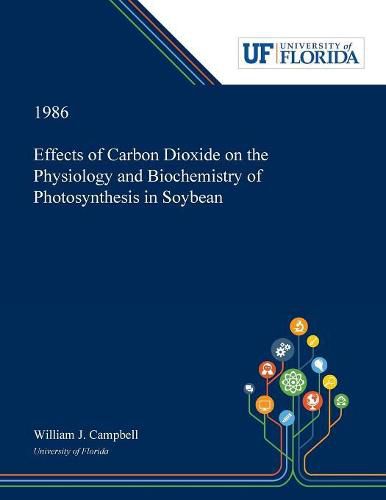Effects of Carbon Dioxide on the Physiology and Biochemistry of Photosynthesis in Soybean
William Campbell

Effects of Carbon Dioxide on the Physiology and Biochemistry of Photosynthesis in Soybean
William Campbell
Abstract: In three consecutive years (1983, 1984, and 1985) soybeans (Glycine max L. Merr. cv Bragg) were grown from seed to maturity in six outdoor environmentally controlled plant growth chambers under natural solar irradiance. The C0 2 concentrations inside the chambers were controlled to various levels during these studies. Both field and laboratory measurements were made to investigate the effects of CO2 concentration on photosynthesis. Emphasis was placed on the response to C0 2 of ribulose 1, 5-bisphosphate (RuBP) and RuBP carboxylase (RuBPCase), the substrate and enzyme of the carbon fixation reaction in soybean.
Following growth at 330 (atmospheric concentration) or 660 ul CO2 1, leaflet photosynthetic rates were always greater for the elevated Od^ grown plants when measured over a wide range of COn concentrations. This enhanced capacity for photosynthesis was possibly a result of changes in internal leaf anatomy, or to greater assimilate demand, or both, in the high CO- grown plants. The RuBP concentration decreased with increasing CCL, but still appeared to be greater than the active site concentration of RuBPCase. The RuBPCase activity, expressed on an area basis, was not affected by growth CCL concentration. It appears that RuBPCase and RuBP are thus not involved significantly in the enhanced photosynthetic capacity.
Evaporative cooling kept leaf temperatures from reaching the higher air temperatures during studies on temperature effects on soybean grown at atmospheric and twice atmospheric concentrations of C0 . Although air temperatures were increased by approximately 5 and 10 DegreesC, leaf temperatures were usually not increased more than approximately 2.5 and 4.5 DegreesC, respectively. These leaf temperature increases were not great enough to affect canopy photosynthesis or RuPBCase activity (on a chlorophyll basis) in either CCL treatment.
Canopy photosynthesis was, however, greater at the higher CCL concentration. The concentration of RuBP was reduced at higher temperatures.
Increasing growth CCL concentrations (from 160 to 990 jul CCL 1 ) resulted in decreasing RuBPCase activities and RuBP levels, when both were expressed on a chlorophyll basis. At the higher C0 concentrations, the concentration of RuBP appeared to approach the concentration of RuBPCase active sites. Both the apparent K (C0? ) and V of RuBPCase showed small, but statistically significant, decreases with increasing C0
Dissertation Discovery Company and University of Florida are dedicated to making scholarly works more discoverable and accessible throughout the world. This dissertation, Effects of Carbon Dioxide on the Physiology and Biochemistry of Photosynthesis in Soybean by William J. Campbell, was obtained from University of Florida and is being sold with permission from the author. A digital copy of this work may also be found in the university’s institutional repository, IR@UF. The content of this dissertation has not been altered in any way. We have altered the formatting in order to facilitate the ease of printing and reading of the dissertation.
This item is not currently in-stock. It can be ordered online and is expected to ship in approx 2 weeks
Our stock data is updated periodically, and availability may change throughout the day for in-demand items. Please call the relevant shop for the most current stock information. Prices are subject to change without notice.
Sign in or become a Readings Member to add this title to a wishlist.


